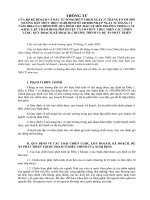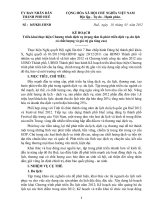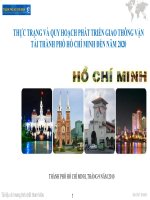Chương I phát triển và quy hoạch du lịch từ thực trạng tới hướng đi
Bạn đang xem bản rút gọn của tài liệu. Xem và tải ngay bản đầy đủ của tài liệu tại đây (444.08 KB, 32 trang )
QUY HOẠCH PHÁT TRIỂN
DU LỊCH
Nội dung học phần
1. Tổng quan về quy hoạch phát triển du
lịch
2. Các yếu tố và điều kiện trong quy
hoạch phát triển du lịch
3. Các công cụ và kỹ thuật trong quy
hoạch và quản lý du lịch
4. Quy hoạch phát triển du lịch bền vững
CHƯƠNG 1
TỔNG QUAN VỀ QUY HOẠCH
PHÁT TRIỂN DU LỊCH
1. Khái niệm quy hoạch du lịch
“Planning is the process of identifying
objectives and defining and evaluating
methods of achieving them”
1.1 Khái niệm quy hoạch du lịch
“A plan... enables us to identify where we
are going and how we get there”
1.1 Khái niệm quy hoạch du lịch
Quy hoạch du lịch là tập hợp lý luận và thực tiễn
nhằm phân bố hợp lý nhất lãnh thổ những cơ sở
kinh doanh du lịch có tính toán tổng hợp các nhân
tố: điều kiện tự nhiên, tài nguyên du lịch, cơ sở hạ
tầng, điều kiện kinh tế-xã hội, môi trường, kiến
trúc xây dựng …
Quy hoạch du lịch còn cụ thể hóa trên lãnh thổ
những dự đoán, định hướng, chương trình và kế
hoạch phát triển du lịch. Đồng thời quy hoạch du
lịch bao gồm cả quá trình ra quyết định thực hiện
quy hoạch, bổ sung các điều kiện phát triển nhằm
đạt được các mục tiêu phát triển du lịch bền vững.
2. Lý do của việc quy hoạch phát triển du
lịch
1. Destination life cycle;
2. More competitive situation;
3. More complicated phenomenon;
4. Tourism has damaged natural and cultural
resources;
5. Community involved
A brief history of modern tourism
planning
Tourism planning is a comparative newcomer.
Early tourism development was founded on a basic assumption: tourism is
an ‘intrinsic goods’. This led to many negative impacts on
environment and society (non-sustainable tourism).
A brief history of modern tourism
planning
Why?
-
There was a lack of adequate foresight about changing tourist trends
and demands and;
-
Little or no awareness of the side-effects on the local area (negative
impacts).
It was the consequences of ‘non-integrated’ approach to tourism
development
A brief history of modern tourism
planning
Phase
1950s
1960s
1970s
1980s to
1990s
1990s to
present
Planning characteristics
Post-war reconstruction and streamlining of many policy regulations. Virtually no public
sector planning in the small-scale tourism industry.
Greater government involvement in tourism marketing and investment incentives in order
to increase tourism earning potential but little critical analysis of the industry, which is not
treated as equal to other industrial sectors.
Government involvement in the supply of tourism infrastructure and in the use of tourism
as a tool of regional development. Tourism planning reaches its apex. Luxury resort
model followed, ‘planners know best’. Transnational tourism companies.
Reduced direct government involvement, greater emphasis on public-private partnerships
and industry self-regulation. Acknowledgement of socio-cultural and environmental
impacts of tourism; some attempts at community involvement.
Recognition that tourism can fail to deliver economic benefits in developing countries
unless carefully planned; a move towards integrated tourism planning.
(adapted from Burns, 1999: 331 & Hall, 2000: 16)
A brief history of modern tourism
planning
From the mid-1960s to the present, integrated planning for development
was more common. There is an increasing acceptance that it
requires planning for achievement of wide-ranging objectives within
the context of sustainable development.
3. Mục đích của quy hoạch phát triển du
lịch
- Identifying alternative approaches;
- Adapting to the unexpected;
- Maintaining uniqueness;
- Creating the desirable;
- Avoiding the undesirable
Why is planning important?
1. Planning can improve the visitor experience:
– Many different sectors must work together to provide the tourism
“product” for the visitor: the visitor experience.
– Good planning enables destinations to carefully consider these different
sectors.
Why is planning important?
Elements of the Visitor Experience
Transportation to/from destination
Marketing (creating expectations)
Quality of Environment
Access
Quality of Accommodations
Quality of Attractions
Quality of Service
Why is planning important?
2. Planning can improve the resident experience:
– Tourism has many different impacts on the destination and the
residents.
– Good planning increases the ability of the destination to anticipate or
avoid negative impacts.
– Good planning enables the destination to maximize the economic
benefits of tourism.
Why is planning important?
Elements of the resident experience
Economic benefits
Quality of jobs
Quality of environment
Quality of infrastructure
Behavior of visitors
Quality of life
Broad approaches to planning
Boosterism: (tourism is good)
views opposition to tourism as ‘unpatriotic’
little consideration of carrying capacity
practised by politicians & those that gain
financially from tourism (Getz, 1987).
Tourism as an industry
Tourism used as a tool by governments to achieve
economic restructuring
Economic goals: priority over social/ecological
questions
Broad approaches to planning
The land use/physical/spatial approach
Minimise negative effects on the environment
by land zoning to concentrate/disperse tourists
Risk plans may ignore more socio/cultural
factors.
Community oriented tourism planning
Recognised need for the social impact
perspective: vital ethically (that people influence
their destination destinies) and economically
(to attract tourists)
Levels of tourism planning
Tourism planning occurs at several different. At each level, there are
different issues.
– International level
– National level
– Regional / State level
– Local or community level
– Site level
Tourism planning confines
Tourism planning has been largely confined to:
-
Designated areas such as national park and heritage sites
-
‘Subject plan’ (plan which focus specially on tourism/leisure)
-
Tourism/leisure as one topic in development plans for an area.
Key actors in the planning process
Residents of host destination area
Environmental advocacy groups
Tourism-related and non-tourism related businesses
Politicians and other elected officials
Labor unions and other employee representatives
Government officials.
Public and Private Planning
Public planning generally involves public
resources and objectives, such as creation of land,
construction of highways, and other infrastructure.
Private sector planning consists of product
development, building, finance, marketing,
management and operations etc,.
4. Quy trình quy hoạch du lịch
Stage 1: Recognizing the need for a tourism plan/strategy
Stage 2: Setting objectives/goals for a specific planning strategy
Why developing tourism?
What benefits are expected from tourism?
Type of tourism and visitor profiles?
Limits on tourism growth?
Time frame for development?
Stage 3: Survey of existing data
Stage 4: Implementation of new surveys
Stage 5: Analysis of secondary and primary data
Stage 6: Plan creation
Stage 7: Recommendations of the plan
Stage 8: Implementation of the plan
Stage 9: Monitoring, evaluation and re-formulation
SURVEYS
Demand Analysis - Existing and Intended Visitor
Market
Market Analysis
Tourist arrivals and characteristics
Travel patterns and trends (season, changes)
Supply Analysis – Destination and its attractions
Attractions, accommodations, and facilities
Transportation network, infrastructure, and manpower
Inventory of Existing Attractions
Inventory of Facilities, services and Infrastructure
Business and Legal environment









